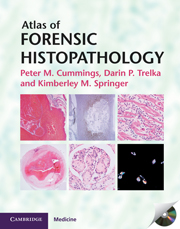2 - Decomposition
Published online by Cambridge University Press: 05 August 2013
Summary
INTRODUCTION
Decompositional change is the sum of the effects of autolytic and putrefactive forces on the body after death. Autolysis is caused by the cessation of metabolic processes that preserve the integrity of cells. Cells begin to disintegrate and their contents, particularly enzymes, work to dissolve surrounding tissue. Putrefaction is caused by bacteria and other organisms digesting tissue. The rate at which decomposition occurs is dependent on several variables, including body habitus, health status (including the presence of antemortem infection or diabetes), and environment. Interpretation of both external and internal autopsy observations is more challenging through the filter of decomposition. However, the added challenge should not preclude the examiner from performing an internal examination. In some cases, the gross findings may be misleading. Examples are dissolution of atheromatous plaques in coronary arteries (giving the misimpression that cardiac disease is absent) and esophageal rupture caused by decomposition-related esophagomalacia (giving the misimpression that the cause of death is a perforated viscus). In this chapter, common decompositional changes in major organs are displayed, along with pathologic processes that can still be seen histologically, despite those changes.
- Type
- Chapter
- Information
- Atlas of Forensic Histopathology , pp. 28 - 35Publisher: Cambridge University PressPrint publication year: 2000



